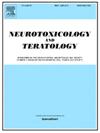极低温加剧了聚苯乙烯微塑料诱导的雌性小鼠神经内分泌和行为功能障碍
IF 2.8
3区 医学
Q3 NEUROSCIENCES
引用次数: 0
摘要
尽管人们越来越认识到微塑料(MPs)的影响和极端天气事件的加剧,但最近的调查主要集中在全球变暖的后果上,而忽视了极端低温(ELT)事件及其与这些污染物的相互作用的潜在影响。因此,本研究的目的是评估环境老化聚苯乙烯微塑料(PS-MPs)和elt共同暴露对雌性瑞士小鼠行为、神经内分泌、代谢和组织形态计量学生物标志物的综合影响。为此,动物口服环境老化的PS-MPs (10 mg/kg/天),并在4°C的气候控制室中保持21天,而对照组则保持在25°C。在行为领域,共同暴露的动物表现出更多的运动紊乱、焦虑样行为、探索效率降低、记忆和社会歧视障碍,这与神经内分泌的改变有关,包括多巴胺、血清素、肾上腺素和皮质酮,这取决于评估的反应。通过荧光显微镜观察,证实了PS-MPs在肩胛间棕色脂肪组织(iBAT)中的保留。它与iBAT的氧化应激、抗氧化防御能力下降和代谢功能障碍有关,ELT暴露加剧了这些影响。多变量分析,包括主成分分析(PCA)、随机森林和结构方程模型(PLS-PM),揭示了组间不同的表型模式,以及将神经内分泌功能障碍与系统性表型改变联系起来的综合因果轨迹。总之,我们的研究证实了最初的假设,表明ELT和PS-MP摄入的结合放大了系统生理功能障碍,超出了每个应激源的影响,突出了恒温哺乳动物在多种环境压力下的脆弱性,并为生态毒理学开辟了新的视角,不仅考虑了全球变暖的影响,而且考虑了ELT与新兴污染物相互作用的有害影响。本文章由计算机程序翻译,如有差异,请以英文原文为准。
Extreme low-temperature exacerbates polystyrene microplastic-induced neuroendocrine and behavioral dysfunctions in female mice
Despite the growing recognition of the impacts of microplastics (MPs) and the intensification of extreme weather events, recent investigations have focused mainly on the consequences of global warming, while overlooking the potential impacts of extreme low-temperature (ELT) events and their interaction with these pollutants. Accordingly, the aim of this study was to assess the integrated effects of co-exposure to environmentally aged polystyrene microplastics (PS-MPs) and ELTs on behavioral, neuroendocrine, metabolic, and histomorphometric biomarkers in female Swiss mice. To this end, animals were orally exposed to environmentally aged PS-MPs (10 mg/kg/day) and maintained in a climate-controlled chamber at 4 °C for 21 days, whereas control groups were kept at 25 °C. In the behavioral domain, co-exposed animals exhibited increased locomotor disorganization, anxiety-like behavior, reduced exploratory efficiency, and impairments in memory and social discrimination, associated with neuroendocrine alterations involving dopamine, serotonin, epinephrine, and corticosterone, depending on the response evaluated. The retention of PS-MPs in the interscapular brown adipose tissue (iBAT) was confirmed by epifluorescence microscopy. It was associated with oxidative stress, decreased antioxidant defenses, and metabolic dysfunction in iBAT, effects exacerbated by ELT exposure. Multivariate analyses, including principal component analysis (PCA), Random Forest, and structural equation modeling (PLS-PM), revealed distinct phenotypic patterns among groups, as well as integrated causal trajectories linking neuroendocrine dysfunction to systemic phenotypic alterations. In conclusion, our study confirms the initial hypothesis by demonstrating that the combination of ELT and PS-MP ingestion amplifies systemic physiological dysfunctions beyond the effects of each individual stressor, highlighting the vulnerability of homeothermic mammals under multiple environmental pressures, and opening new perspectives for ecotoxicology to consider not only the impacts of global warming, but also the deleterious effects of ELTs in interaction with emerging pollutants.
求助全文
通过发布文献求助,成功后即可免费获取论文全文。
去求助
来源期刊
CiteScore
5.60
自引率
10.30%
发文量
48
审稿时长
58 days
期刊介绍:
Neurotoxicology and Teratology provides a forum for publishing new information regarding the effects of chemical and physical agents on the developing, adult or aging nervous system. In this context, the fields of neurotoxicology and teratology include studies of agent-induced alterations of nervous system function, with a focus on behavioral outcomes and their underlying physiological and neurochemical mechanisms. The Journal publishes original, peer-reviewed Research Reports of experimental, clinical, and epidemiological studies that address the neurotoxicity and/or functional teratology of pesticides, solvents, heavy metals, nanomaterials, organometals, industrial compounds, mixtures, drugs of abuse, pharmaceuticals, animal and plant toxins, atmospheric reaction products, and physical agents such as radiation and noise. These reports include traditional mammalian neurotoxicology experiments, human studies, studies using non-mammalian animal models, and mechanistic studies in vivo or in vitro. Special Issues, Reviews, Commentaries, Meeting Reports, and Symposium Papers provide timely updates on areas that have reached a critical point of synthesis, on aspects of a scientific field undergoing rapid change, or on areas that present special methodological or interpretive problems. Theoretical Articles address concepts and potential mechanisms underlying actions of agents of interest in the nervous system. The Journal also publishes Brief Communications that concisely describe a new method, technique, apparatus, or experimental result.

 求助内容:
求助内容: 应助结果提醒方式:
应助结果提醒方式:


